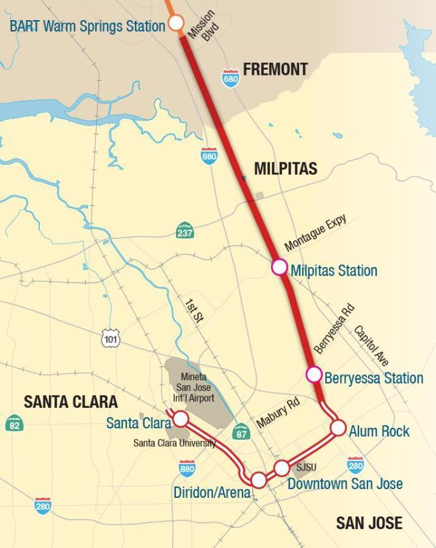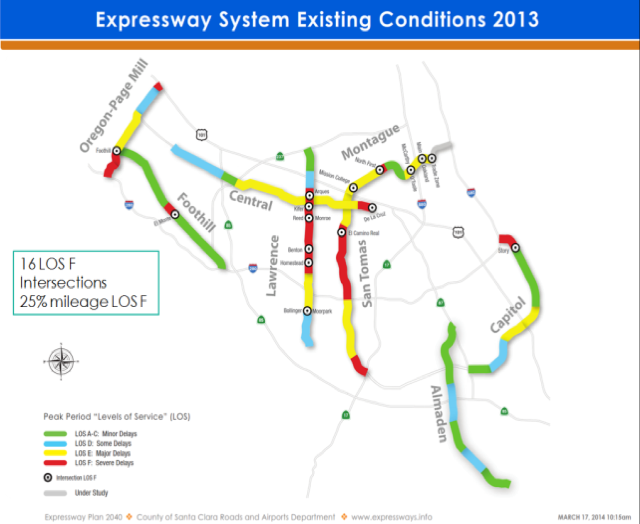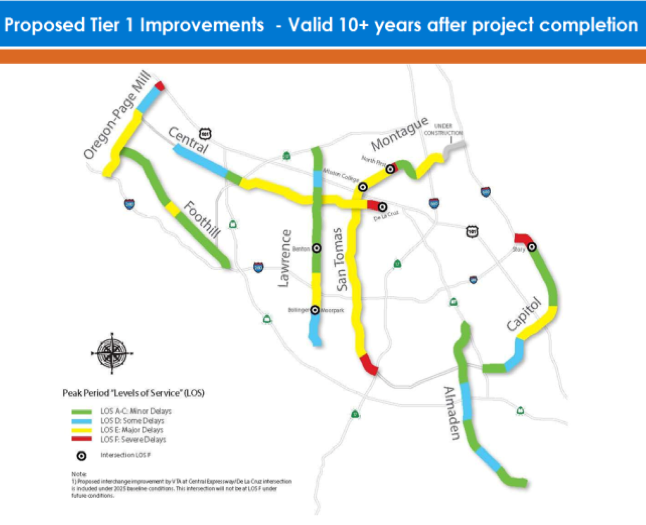Q. How will Measure B improve our commutes and our roads?
Measure B will:
- Finish the BART extension to downtown San Jose and Santa Clara
- Relieve traffic congestion on all 10 Expressways (Almaden, Capitol, Central, Foothill, Lawrence, Montague, Page Mill, San Tomas, Santa Teresa/Hale) and key highway interchanges
- Protect and enhance transit options for seniors, the disabled, students and the poor
- Repair roads and fix potholes in all 15 cities
- Improve bicycle and pedestrian safety, especially near schools
- Increase Caltrain capacity, easing highway congestion and improving safety at grade crossings
- Connect BART and Caltrain in downtown San Jose and Santa Clara, with platform-to-platform connections, to finally provide rapid rail around the entire Bay Area
Q. Why is Measure B important?
We are fortunate to enjoy a special quality of life here in Santa Clara County. Unfortunately, many of Santa Clara County’s roads are in dire need of repair and we’re spending too much time trapped in traffic. We need meaningful countywide commute relief. Residents, employees and businesses rely on our roads and alternative transportation methods to be well maintained and safe. Each year we wait to provide additional funding, road repairs and transportation improvements become more expensive. Measure B will provide Santa Clara County with a guaranteed source of local controlled funding to repair and maintain our roads and improve safety.
Q. How do I know that Measure B funds will be spent as promised?
Measure B creates dedicated local funding that can only be used to provide better commutes and better roads to Santa Clara County. The state or federal government cannot take away Measure B Funds. Additionally, Measure B mandates strong taxpayer safeguards, including independent financial audits with citizen oversight. Elected leaders will be held accountable to spend funds as promised.
Q. What is BART Phase II?
VTA’s BART Silicon Valley is currently completing Phase I which is an extension BART through Fremont and Milpitas. Phase II would connect the Berryessa station to four new stations: Alum Rock, Downtown San Jose, Diridon/Arena, and Santa Clara. This extension is expected to add a convenient mode of travel for 90,000 daily riders, decrease road congestion, and reduce greenhouse gas emissions by 32 million pounds each year - the equivalent of 3,066 cars off the road annually..
Q. How will the Caltrain capacity improvements impact the whole county?
The improvements include creating more space for riders, facilitating a faster loading/unloading process, and increasing train service, and bypass traffic through grade separations. There are funds for an additional train that will run from Gilroy and Morgan Hill to San Jose to accommodate the increasing need.
Q. What is a grade separation and how would this improve traffic conditions?
A grade separation is a difference in elevation between the tracks and the road. This might take the form of an elevated road so that train and road traffic do not impact each other.
Q. Can you tell me the highway improvements that would be funded by Measure B?
US 101- Improvements in the cities of Palo Alto and Mountain View to address regional connectivity and circulation between San Antonio Road and Charleston Road at the US 101/San Antonio Road, US 101/Rengstorff/Charleston Road and US 101/Shoreline Boulevard interchanges.
- SR 237/US 101/Mathilda Avenue Area Improvements in Sunnyvale to address local roadway congestion.
- US 101/Trimble Road/De La Cruz Boulevard to Zanker Road Area Improvements to address local roadway connectivity and mainline congestion in San Jose and Santa Clara with US
- 101/Trimble Road/De La Cruz Boulevard interchange improvements, southbound US 101/SB 87 connector improvements, and a new US 101/Zanker Road interchange.
- US 101/Old Oakland Road Improvements in San Jose to address local roadway congestion, access and connectivity.
- A new interchange at US 101/Mabury Road in San Jose to address regional access. cess and connectivity.
- US 101/Blossom Hill Boulevard improvements in San Jose to address local roadway congestion and connectivity including for bicyclists and pedestrians
- US 101 Improvements in Gilroy to address mainline congestion and regional connectivity with a new US 101/Buena Vista Avenue interchange and US 101/SR 152 10th Street ramp and intersection improvements.
- Highway 17 Corridor Congestion Relief: Upgrade Highway 17/9 interchange to improve pedestrian and bicycle safety, mobility, and roadway operations; deploy advanced transportation technology to reduce freeway cut thru traffic in Los Gatos, including traffic signal control system upgrades in Los Gatos, Traveler Information System, advanced ramp metering systems; support Multi-Modal Congestion Relief Solutions, including enhanced Highway 17 Express Bus service, implementing local bus system improvements that reduce auto trips to schools, work, and commercial areas in Los Gatos; and develop park and ride lots to serve as transit hubs for express bus, shuttles, local bus system connections.
- SR 17 Southbound/Hamilton Avenue Off-ramp Widening Improvements in Campbell to address mainline congestion and local circulation.
- SR 17/San Tomas Expressway Improvements in Campbell to address mainline congestion and local circulation.
- SR 237 Area Improvements in Mountain View to address mainline congestion and regional connectivity through the SR 85/SR 237 connector, SR 85/El Camino Real interchange, and the SR 237/El Camino/Grant Road interchange.
- SR 85/I-280 Area Improvements in Cupertino, Los Altos, and Sunnyvale to address regional connectivity through a northbound I-280 braided ramp between SR 85 and Foothill Boulevard and improvements at the northbound I-280 off-ramp to Foothill Boulevard.
- SR 87 Corridor Technology-based Improvements in San Jose to address mainline congestion and system reliability through the implementation of technology-based operational improvements to the freeway.
- SR 152 Corridor Improvements in Gilroy including US 101/SR 25 interchange improvements to address regional connectivity and goods movement network improvements.
- Corridor Improvements in the cities of San Jose, Santa Clara and Milpitas to address mainline congestion and regional connectivity by addition of SR 237 westbound/eastbound auxiliary lanes between Zanker Road and North First Street, improvements at the SR 237/Great America Parkway westbound off-ramp, and replacement/widening of the Calaveras Boulevard structures over the UPRR tracks.
- SR 237/US 101/Mathilda Avenue Area Improvements in Sunnyvale to address local roadway congestion.
- West County Improvements along I-280 in Cupertino, Los Altos, Los Altos Hills and Sunnyvale to address mainline congestion with mainline and interchange improvements from Magdalena Avenue to the San Mateo County line.
- SR 85/I-280 Area Improvements in Cupertino, Los Altos, and Sunnyvale to address regional connectivity through a northbound I-280 braided ramp between SR 85 and Foothill Boulevard and improvements at the northbound I-280 off-ramp to Foothill Boulevard.
- I-280/Lawrence Expressway/Stevens Creek Boulevard Interchange Improvements to address mainline and local roadway congestion.
- I-280/Saratoga Avenue Interchange Improvements to address local circulation and mainline congestion.
- I-280/Winchester Boulevard Area Improvements in Santa Clara and San Jose to address regional connectivity and local circulation.
- I-280/Wolfe Road Interchange Improvements in Cupertino to address mainline congestion and improve local traffic circulation.
- I-680 Corridor Improvements in San Jose to address mainline congestion and regional connectivity by improving the I-680/Alum Rock Avenue and I-680/McKee Road interchanges.
- ● I-880/Charcot Avenue Overcrossing in San Jose to address local relief circulation and adjacent I-880 interchanges congestion relief.
Noise Abatement Projects in Santa Clara County to implement treatments to address existing freeway noise levels throughout the county. Intelligent Transportation Systems (ITS) Projects in Santa Clara County such as integrated corridor management systems, traffic operations systems, ramp metering, managed lanes, and local traffic signal control systems to address freeway mainline congestion and local roadway congestion caused by cut-through traffic.
Q. What if I have questions about voting on Measure B?
To register to vote please visit http://registertovote.ca.gov. If you are unsure if you are registered to vote or do not receive your absentee ballot the week of October 10, please call (408) 299-VOTE [8683] or visit https://www.sccgov.org/sites/rov.
Q. How are our roads funded and transportation options funded?
We are too reliant on unstable and declining transportation funds that come from Sacramento and Washington, D.C. Measure B will be on the November 2016 ballot, which if passed will provide a guaranteed source of local funding. Securing local funding also helps Santa Clara County secure state and federal matching funds that would otherwise be lost to other regions.
Q. When can I vote on Measure B?
Measure B will appear on the November 8, 2016 ballot. All registered voters in Santa Clara County will be eligible to vote on Measure B. Absentee voters should expect to receive their ballot in the mail the week of October 10. The deadline to register to vote in this election is October 24. Measure B must receive two-thirds approval in order to pass.
Q. Where can I find the official VTA documentation that will become law?
Here is a link to the official VTA Resolution voted on by the Board of Directors.
Q. Who is considering this sales tax measure?
The ½-cent, 30-year sales tax measure will be on the November 2016 ballot for Santa Clara County residents.
Q. How much revenue would this tax generate?
According to the UCLA Anderson School of Management, a ½-cent, 30-year tax is projected to raise approximately $6 - $6.5 billion. The estimated funds available for the nine project categories are based on a $6.314 billion projection.
Q. Where would the funds from this sales tax go?
Funds would go toward addressing growing demands for a reliable, cost-effective and efficient transportation system needed to relieve congestion, improve mobility for all County residents, adapt to changes in land use and demographics, and maintain the region’s economic vitality.
Q. How certain is VTA that a sales tax would raise the projected amount, especially since economic downturns since the year 2000 have reduced sales tax receipts?
While no one can predict future economic cycles with certainty, sales taxes remain one of the most efficient ways to broadly generate funds for transportation projects that benefit all County residents. Any forecast is affected by economic upturns and downturns, such as recessions. If deep recessions take place in earlier years of a sales tax collection, this could significantly reduce overall projected revenue.
Q. Can revenue collected from a transportation sales tax measure be used for other purposes?
No. A transportation sales tax measure can only be used to fund transportation projects and programs identified in the measure.
Q. My city has maintained roads using other funds, will this negatively impact how much money my city will receive?
Allocated funding for roadway maintenance is based on how much pavement each city has. Cities that have maintained good roads will still receive allocated funds and will have flexibility in how these funds are spent.
Q. I have sat through multiple light changes before making it through several intersections on county expressways; how will funds from this tax improve overcrowded expressways?
There are twenty projects on all nine county expressways including Intelligent Transportation Systems (ITS)/Signal System Countywide. Projects include improvements at key intersections, addition of auxiliary lanes, grade separations, some widening with addition of HOV lanes, and addition of trails. Traffic projections show that these projects will significantly improve wait times at intersections even ten years after they are completed.
. .
.
.
.
Q. Can you tell me the Expressway improvements that would be funded by Measure B?
Almaden Expressway- Improvements at Highway 85, Branham Lane, and Camden Ave
- Widening and Interchange Modifications between I-680 and Capitol Avenue
- Improvements at Thompson
- Auxiliary Lanes between El Monte and San Antonio
- I-280/Foothill Expressway Interchange Modifications and Auxiliary Lane to Homestead
- Improvements at Homestead Road
- Grade Separation at Homestead Road and from Reed/Monroe to Arques
- Complete 8-lane Widening including HOV lanes
- Auxiliary Lanes between Great Mall and McCarthy/O'Toole
- Widening (possible HOV lanes)
- ATrail between I-280 and Foothill Expressway
- Improvements between Porter and Hansen and El Camino Real
- I-280/Oregon-Page Mill Road Interchange Reconfiguration
- Widening and Trail between Homestead and Stevens Creek
- Improvements at Highway 17
- Road and Trail between Dewitt and Main
- Widening and Trail between Long Meadow and Fitzgerald
Q. Why is the focus on highway interchanges?
Of the twenty-four proposed projects, only a few include suggestions for widening. The focus is on improving the functionality of the space we already have by improving the connectivity, specifically in the on/off ramps and adding auxiliary lanes. These types of projects enhance safety and reduce congestion.
Q. I don’t use transit and don’t want to; what’s in this for me?
As the Congestion Management Agency for Santa Clara County, VTA not only oversees transit, but also helps fund and/or construct local street and road projects, highways, local operations systems (e.g., signals, traffic management systems), bike/pedestrian projects and expressways.
Q. What if I need more information about Measure B?
For more information please contact us at info@YesMeasureB.com or (408) 883-YESB.
How Measure B Benefits Me
Learn about how Measure B will improve your community by selecting it from the list.

